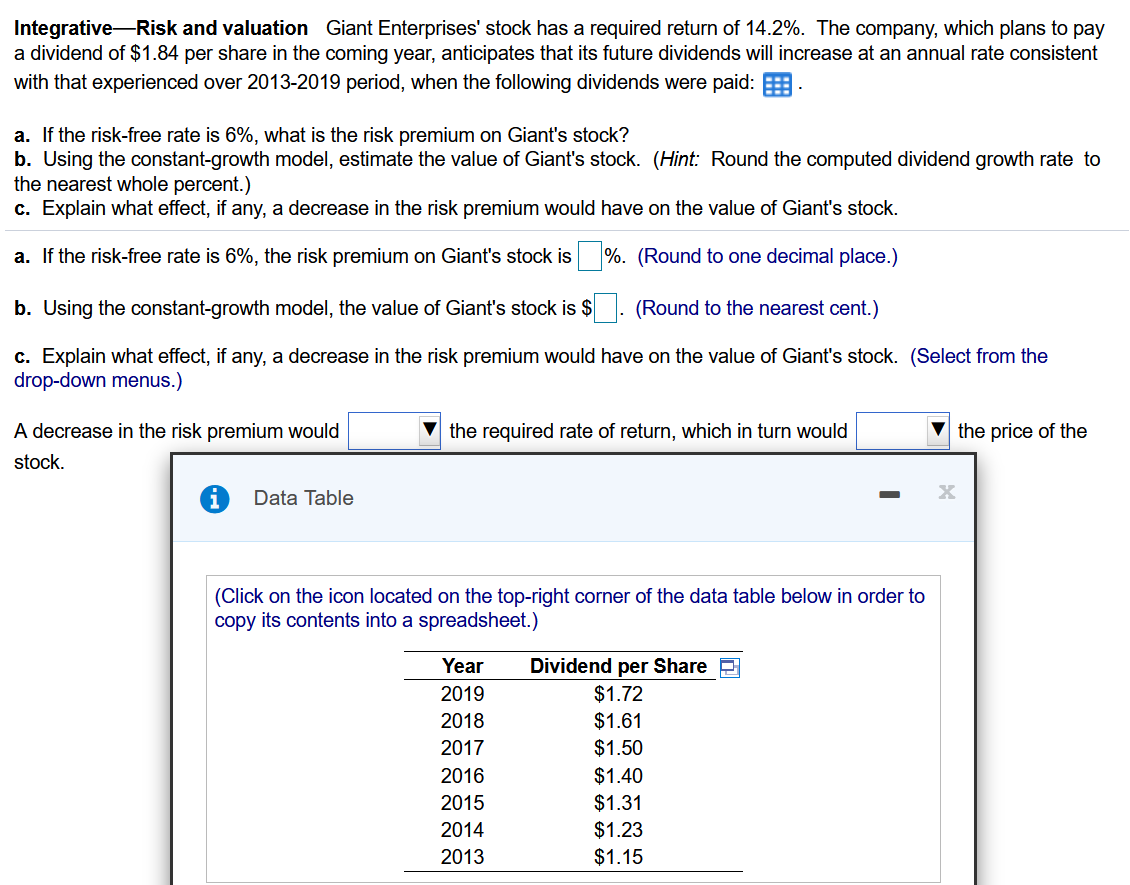Integrative-Risk and valuation Giant Enterprises' stock has a required return of 14.2%. The company, which plans to pay a dividend of $1.84 per share in the coming year, anticipates that its future dividends will increase at an annual rate consistent with that experienced over 2013-2019 period, when the following dividends were paid: E. a. If the risk-free rate is 6%, what is the risk premium on Giant's stock? b. Using the constant-growth model, estimate the value of Giant's stock. (Hint: Round the computed dividend growth rate to the nearest whole percent.) c. Explain what effect, if any, a decrease in the risk premium would have on the value of Giant's stock. a. If the risk-free rate is 6%, the risk premium on Giant's stock is %. (Round to one decimal place.) b. Using the constant-growth model, the value of Giant's stock is $. (Round to the nearest cent.) c. Explain what effect, if any, a decrease in the risk premium would have on the value of Giant's stock. (Select from the drop-down menus.) A decrease in the risk premium would the required rate of return, which in turn would the price of the stock. Data Table (Click on the icon located on the top-right corner of the data table below in order to copy its contents into a spreadsheet.) Year Dividend per Share P 2019 $1.72 $1.61 $1.50 2018 2017 $1.40 $1.31 $1.23 $1.15 2016 2015 2014 2013
Integrative-Risk and valuation Giant Enterprises' stock has a required return of 14.2%. The company, which plans to pay a dividend of $1.84 per share in the coming year, anticipates that its future dividends will increase at an annual rate consistent with that experienced over 2013-2019 period, when the following dividends were paid: E. a. If the risk-free rate is 6%, what is the risk premium on Giant's stock? b. Using the constant-growth model, estimate the value of Giant's stock. (Hint: Round the computed dividend growth rate to the nearest whole percent.) c. Explain what effect, if any, a decrease in the risk premium would have on the value of Giant's stock. a. If the risk-free rate is 6%, the risk premium on Giant's stock is %. (Round to one decimal place.) b. Using the constant-growth model, the value of Giant's stock is $. (Round to the nearest cent.) c. Explain what effect, if any, a decrease in the risk premium would have on the value of Giant's stock. (Select from the drop-down menus.) A decrease in the risk premium would the required rate of return, which in turn would the price of the stock. Data Table (Click on the icon located on the top-right corner of the data table below in order to copy its contents into a spreadsheet.) Year Dividend per Share P 2019 $1.72 $1.61 $1.50 2018 2017 $1.40 $1.31 $1.23 $1.15 2016 2015 2014 2013
Chapter12: The Cost Of Capital
Section: Chapter Questions
Problem 23P
Related questions
Question

Transcribed Image Text:Integrative-Risk and valuation Giant Enterprises' stock has a required return of 14.2%. The company, which plans to pay
a dividend of $1.84 per share in the coming year, anticipates that its future dividends will increase at an annual rate consistent
with that experienced over 2013-2019 period, when the following dividends were paid: E-
a. If the risk-free rate is 6%, what is the risk premium on Giant's stock?
b. Using the constant-growth model, estimate the value of Giant's stock. (Hint: Round the computed dividend growth rate to
the nearest whole percent.)
c. Explain what effect, if any, a decrease in the risk premium would have on the value of Giant's stock.
a. If the risk-free rate is 6%, the risk premium on Giant's stock is
%. (Round to one decimal place.)
b. Using the constant-growth model, the value of Giant's stock is $
(Round to the nearest cent.)
c. Explain what effect, if any, a decrease in the risk premium would have on the value of Giant's stock. (Select from the
drop-down menus.)
A decrease in the risk premium would
V the required rate of return, which in turn would
the price of the
stock.
Data Table
(Click on the icon located on the top-right corner of the data table below in order to
copy its contents into a spreadsheet.)
Year
Dividend per Share E
2019
$1.72
2018
$1.61
$1.50
2017
$1.40
$1.31
$1.23
$1.15
2016
2015
2014
2013
Expert Solution
This question has been solved!
Explore an expertly crafted, step-by-step solution for a thorough understanding of key concepts.
This is a popular solution!
Trending now
This is a popular solution!
Step by step
Solved in 5 steps

Knowledge Booster
Learn more about
Need a deep-dive on the concept behind this application? Look no further. Learn more about this topic, finance and related others by exploring similar questions and additional content below.Recommended textbooks for you

EBK CONTEMPORARY FINANCIAL MANAGEMENT
Finance
ISBN:
9781337514835
Author:
MOYER
Publisher:
CENGAGE LEARNING - CONSIGNMENT

Intermediate Financial Management (MindTap Course…
Finance
ISBN:
9781337395083
Author:
Eugene F. Brigham, Phillip R. Daves
Publisher:
Cengage Learning

Pfin (with Mindtap, 1 Term Printed Access Card) (…
Finance
ISBN:
9780357033609
Author:
Randall Billingsley, Lawrence J. Gitman, Michael D. Joehnk
Publisher:
Cengage Learning

EBK CONTEMPORARY FINANCIAL MANAGEMENT
Finance
ISBN:
9781337514835
Author:
MOYER
Publisher:
CENGAGE LEARNING - CONSIGNMENT

Intermediate Financial Management (MindTap Course…
Finance
ISBN:
9781337395083
Author:
Eugene F. Brigham, Phillip R. Daves
Publisher:
Cengage Learning

Pfin (with Mindtap, 1 Term Printed Access Card) (…
Finance
ISBN:
9780357033609
Author:
Randall Billingsley, Lawrence J. Gitman, Michael D. Joehnk
Publisher:
Cengage Learning

Fundamentals Of Financial Management, Concise Edi…
Finance
ISBN:
9781337902571
Author:
Eugene F. Brigham, Joel F. Houston
Publisher:
Cengage Learning


Fundamentals of Financial Management, Concise Edi…
Finance
ISBN:
9781285065137
Author:
Eugene F. Brigham, Joel F. Houston
Publisher:
Cengage Learning